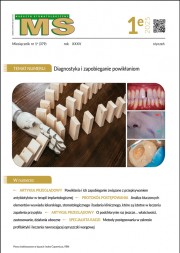Dostęp do tego artykułu jest płatny.
Zapraszamy do zakupu!
Po dokonaniu zakupu artykuł w postaci pliku PDF prześlemy bezpośrednio pod twój adres e-mail.
Streszczenie
W pracy przedstawiono przypadek odbudowy pierwszego zęba trzonowego dolnego kompozytowym nakładem koronowym metodą pośrednią. W zębach z rozległymi ubytkami klasy II MOD można zastosować odbudowę metodą bezpośrednią lub pośrednią. Zaletami metody pośredniej są: pionowe przenoszenie sił żucia przez rekonstrukcję na tkanki zęba, minimalizacja skurczu polimeryzacyjnego materiału oraz precyzyjne odwzorowanie punktu stycznego i powierzchni żującej zęba. Nie można zapomnieć o ograniczeniach metody pośredniej. W przypadku ubytków poddziąsłowych pobranie precyzyjnego wycisku pola protetycznego jest utrudnione, a tym samym także cementowanie adhezyjne uzupełnienia, które wymaga suchości pola protetycznego odizolowanego koferdamem.
Abstract
The article describes the reconstruction of the first lower molar with a composite onlay with the use of indirect technique. In teeth with extensive class II MOD cavities direct or indirect reconstruction
can be used. The advantages of the indirect method are the vertical transfer of occlusal forces by reconstruction into the tooth tissues, minimizing the polymerization shrinkage of the material,
and precise reproduction of the tangential and chewing surfaces of the tooth. You can not forget the limitations of the indirect technique. In the case of subgingival cavities the exact impression
of the prosthetic field is difficult to obtain as well as the adhesive cementation of the restoration, which requires the dryness of the prosthetic field and its isola tion with the rubber dam.
Hasła indeksowe: odbudowa zęba, nakład kompozytowy, metoda pośrednia
Key words: tooth reconstruction, composite onlay, indirect technique














